| This article may require cleanup to meet Tractor Wiki's quality standards. (Consider using more specific cleanup instructions.) Please help improve this article if you can. The talk page may contain suggestions. |

symbols of buses
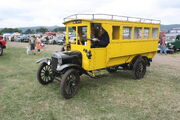
Early Motor Bus built on a ford truck chassis from the 1920's
A bus (or omnibus or autobus) is a road vehicle designed to carry passengers than an average car, such as Chevrolet Spark, Honda City, Renault Symbol, Isuzu Gemini, Honda Jazz, Maruti Suzuki Swift DZire, Suzuki Alto, Suzuki Swift Hatchback, Hyundai i20, Hyundai Accent, BMW 3 Series, Checker Marathon, Daewoo Lanos, Chevrolet Cobalt SS, Checker Aerobus, Daewoo LeMans, Ford Bronco II, Vauxhall Corsa, Volvo S80, Honda Civic, Volvo S70, Chevrolet Aveo, Chevrolet Cruze, Audi 100, Hyundai Elantra, Ford Focus, Kia Rio, Chevrolet Camaro, Dodge Charger, Dodge Colt, Mercedes-Benz CLK, Nissan Quest, Chevrolet Malibu, JAC Heyue, JAC Binyue, Volvo S60, Volvo C70, Ford Pinto, Jeep Wagoneer, Ford Bronco, Volkswagen Eos, Opel Cascada, BMW M6, Renault Talisman, Mitsubishi Lancer, Acura ILX, Audi A3, BMW 1 Series, Volkswagen Golf, Volkswagen Jetta, Morris Oxford, Mahindra Bolero, Hindustan Ambassador, Refine M6, JAC Refine M4, Land Rover Defender, Daihatsu Terios, Opel Meriva, Fiat 500L, JAC Heyue Tongyue, Ford EcoSport, Jeep Renegade, Renault Fluence, Peugeot 2008, Suzuki Jimny, Bentley Arnage, Renault Mégane, Mazda6, Audi A8, JAC Heyue A30, BMW 2 Series, BMW 7 Series, Jaguar XJ, Toyota Vellfire, JAC Refine A60, Lexus CT, Buick Skyhawk, Citroën C3 Picasso, Citroën C5, Vauxhall VXR8, Citroën C1, Toyota Crown, Jeep Wagoneer SJ, Morris Cowley, Dodge Aries, JAC Heyue A20, Toyota Yaris, Ford Pinto, JAC Rein, Hindustan Landmaster, Kia Venga, Jeep Patriot, Renault Espace, Nissan Xterra, Bendix SWC, Lincoln MKS, Ford B-Max, Audi A8, Ford Crown Victoria, Mercedes-Benz A-Class, Chevrolet Tavera, Jeep Liberty, Jeep Wrangler, JAC Refine M3, Lincoln Navigator, Range Rover, JAC Refine M2, Chevrolet Suburban, Hindustan Contessa, BMW M5, Toyota Land Cruiser, Mercedes-Benz GLS-Class, Chrysler Pacifica (RU), Kia Carnival, Toyota Sienna, Citroën C4 Grand Picasso, Rolls-Royce Corniche, Mercedes-Benz S-Class, Porsche Panamera, Lincoln Town Car, Volkswagen Passat, Austin Allegro, Chevrolet Orlando, Ford C-Max, JAC Heyue A20, Suzuki Ertiga, Renault Scénic, Cadillac Escalade, Tesla Model Y, Volkswagen Touareg, Mercedes-Benz Vaneo, Mercedes-Benz G-Class, Ford LTD Crown Victoria, Proton Saga, Toyota Innova, Chevrolet S10 Blazer, Vauxhall Victor, Ford Country Squire, Land Rover Discovery, Volvo XC90, Chevrolet Cavalier, Toyota RAV4, Ford Escape, Honda CR-V, Bentley Brooklands, Nissan Leopard, Toyota Avanza, Kia Sportage, Volkswagen Touran, JAC Yueyue, Ford LTD, Ford Mondeo, BMW i8, JAC Refine M5, Mercedes-Benz V-Class, Fiat Grande Punto Abarth, Rolls-Royce Silver Spirit, Peugeot 508, Audi A6, Fiat Punto, Ford Edge, Hyundai Santa Fe, Jeep Grand Cherokee, BMW 5 Series, Cadillac CT5, Mercedes-Benz Viano, Mercedes-Benz E-Class, Rolls-Royce Phantom (2003), Tesla Model S, Dacia Logan, Lincoln Continental, Dacia Sandero, Ford Flex, Morris Minor, Mercedes-Benz A-Class, Chrysler Town and Country, Volkswagen Polo, Chevrolet Impala, Chrysler 300, Ford LTD II, Ford Taurus, Holden Caprice, Fiat Punto Evo, Citroën C4, Citroën C3, Toyota Avalon, Dodge Caravan, Ford Windstar, Renault Twingo, Fiat 500, Kia Picanto, and Toyota Camry or passenger van, such as the Chevrolet Express Passenger Van, Fiat Ducato Passenger Van, Fiat Scudo Passenger Van, Opel Vivaro Passenger Van, Ford E-Series Passenger Van, Ford Transit Passenger Van, Ford Transit Custom Passenger Van, Renault Trafic Passenger Van, Dodge Ram Van Passenger Van, Toyota HiAce Commuter, Chevrolet Chevy Van/GMC Vandura Passenger Van, Mercedes-Benz Sprinter Passenger Van, Mercedes-Benz Vario Passenger Van, Peugeot Boxer Passenger Van, Dacia Dokker Passenger Van, Opel Combo Passenger Van, Ford Aerostar Passenger Van, Ford Transit Connect Passenger Van, Foton Toano Passenger Van, Ford Transit Courier Passenger Van, Peugeot Expert Passenger Van, Mercedes-Benz W638 Passenger Van, Mercedes-Benz W639 Passenger Van, Mercedes-Benz W447 Passenger Van, Mercedes-Benz MB100 Passenger Van, Fiat Talento Passenger Van, Foton View Passenger Van, Mercedes-Benz T2 Passenger Van, Hyundai Starex Passenger Van, Hyundai H350 Passenger Van, King Long Kaige Passenger Van, Kia Besta Passenger Van, Kia Pregio Passenger Van, Renault Estafette Passenger Van, Harburg Transporter Passenger Van, Nissan NV200 Passenger Van, General Motors G-Series Passenger Vans, Ford Taunus Transit Passenger Van, GAZ Sobol Passenger Van, Bedford CA Passenger Van, Bedford CF Passenger Van, Commer FC Passenger Van, SsangYong Istana Passenger Van, GAZ GAZelle Passenger Van, Volkswagen Type 2 (T1) Passenger Van, Volkswagen Type 2 (T2) Passenger Van, Volkswagen Type 2 (T3) Passenger Van, Morris Minor Passenger Van, Volkswagen Transporter T4 Passenger Van, UAZ-452 Passenger van, GAZelle-Next Passenger Van, Fiat 238 Cargo Van, Fiat 241 Cargo Van, Fiat 242 Passenger Van, Toyota Dyna/Hino Dutro Route Van, RAF-977 Passenger Van, Volkswagen Transporter T5 Passenger Van, Volkswagen Transporter T6 Passenger Van, Nissan Trade Passenger Van, Nissan Interstar Passenger Van, Nissan NV400 Passenger Van, Nissan NV Passenger Van, Isuzu Elf Route Van, Isuzu Fargo Passenger Van, Morris Commercial J4 Passenger Van, JAC Sunray Passenger Van, RAF-2203 Passenger Van, LDV Convoy Passenger Van, LDV Pilot Passenger Van, LDV Maxus Passenger Van, Mitsubishi Delica Passenger Van, Hyundai H100 Cargo Van, Iveco Daily Passenger Van, DKW Schnellaster Passenger Van, Mazda Bongo Passenger Van, FSC Lublin Passenger Van, GMC Savana Passenger Van, Dodge A100 Passenger Van, Chevrolet Greenbrier Passenger Van, Opel Movano Passenger Van, Mercedes-Benz TN Passenger Van, Fordson Thames 400E Passenger Van, Nissan Caravan Passenger Van, and Renault Master Passenger Van, but less than the average rail transport like Amtrak, Metra, VIA Rail, Union Pacific, BNSF, CSX, Indian Railways, Korail, Southern Pacific, Norfolk Southern, Shinkansen, Canadian National, Canadian Pacific, Ferromex and Kansas City Southern. A bus can generally seat a maximum of anywhere from 8 to 300 passengers.[1] Buses are one of the most widely used form of public transportation (depending on how you count numbers, by vehicles, passengers carried, passenger miles etc.)
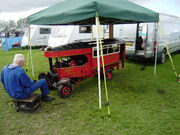
A typical early steam bus (Working scale model)
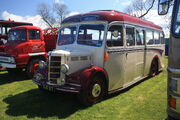
A typical 1940s bus
The most common type of bus is the single-decker bus, with larger loads carried by double-decker buses and articulated buses, and smaller loads carried by midibuses and minibuses. A more luxurious version of the bus is the coach. Buses are usually powered by a diesel engine, although early buses were horse drawn and there were experiments with steam propulsion. Trolleybuses use power drawn from overhead power lines. In common with the car industry bus manufacturing is increasingly a globalised activity, with the same design of bus appearing on roads around the world.
Etymology[]
Bus is a derivation of Omnibus Vehicle meaning "vehicle for all", where omnibus means "for all" in Latin (omnes meaning "all"), reflecting its early usage for public transport. When motorized transport replaced horse-drawn transport starting around 1905, a motorized omnibus was for a time sometimes called an autobus, a term still used in French and other languages, and in some varieties of English.
Pronunciation[]
IPA bʌs, or in some dialects buːs, plural may be either "buses" or "busses", both pronounced bʌsɪz.
History[]
There are indications of the first bus dating back to 1662,[2] although serious horse drawn public transport bus services were not launched until the 1820s. Early buses were horse drawn vehicles, a combination of the hackney carriage and stagecoach concepts. From the 1830s the steam powered bus also existed. In parallel to the development of the bus, was the invention of the electric trolleybus running under a system of wires, which actually preceded, and in many urban areas outnumbered, the conventional engine powered bus. The first engine powered buses emerged along with development of the automobile. After the first engine powered bus of 1895, models expanded in the 1900s, leading to the widespread introduction of the contemporary recognisable form of full size buses from the 1950s.
Designs[]
The names of different types of bus vary around the world according to local tradition or marketing, although buses can be classified into basic types based on their general features.
Since motorisation, the traditional configuration of a bus was an engine in the front and an entrance at the rear. Since the 1960s, with the transition to one man operation, buses in the developed world have taken the form of mid or rear-engined designs, with a single door at the front, or multiple doors, depending on need. Front-engined buses still persist for niche markets such as American school buses, some minibuses, and buses in less developed countries, which may be derived from truck chassis, rather than purpose built bus designs.
A bus may have an open platform so that passengers can join and alight without for the driver to open doors, but in many countries this is considered dangerous and is discouraged or indeed illegal.[citation (source) needed] On the other hand, in some countries bus use is so heavy that passengers will cling to the outside of the vehicle if it is full.[citation (source) needed]
Buses will often have a legal maximum capacity of passengers.
While most bus and coach designs will normally have two axles (or three for articulated buses), buses and coaches may often be fitted with additional axles to accommodate extra length or weight. This is common on three-axle rigid coaches. This is subject to local regulations.
Single deckers[]
- Main article: Single-decker bus
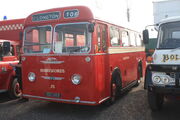
A typical single decker bus from the 1960/70s built on a chassis by Albion
The most common design of bus is a rigid single-decker bus with two axles, or if needed, a second rear axle. The midibus is a lighter and smaller purpose built development of the single deck bus, which emerged in the 1990s. The minibus, originally developed from van conversions, fulfills the lowest capacity needs of buses. Minibuses today are both still derived from vans, or built specifically as minibuses.
Double deckers[]
- Main article: Double-decker bus
Where more capacity is needed, a double-decker bus or articulated bus may be used, the prevalence of which varies from country to country. A double-decker is a rigid vehicle with an extra upper deck, the two conjoined for access by a staircase— usually in modern vehicles a spiral staircase near the front, but often at the rear on older vehicles, which may have an open platform. Larger double deckers might have both front and rear staircases.
Articulated buses[]
- Main article: Articulated bus
Articulated buses take the form of single-decker bus with a 'trailer' portion attached. In articulated buses, drive can be through the front or rear section's axles. In modern articulated buses one can walk between the front and rear sections through an "accordion joint". In the UK and Australia they are often called bendy buses.
Low-floor buses[]
For many new fleets, particularly in local transit systems, there is an increasing shift to low-floor buses (primarily for easier accessibility).
High-floor buses, whose design allows for luggage compartments underneath the passenger seating area, are used for longer-distance intercity travel (see Coaches). The move to the low-floor design has all but eliminated the mid-engined design, although some coaches still have mid mounted engines.
Bi-articulated[]
An uncommon departure from the standard rigid or articulated buses, there also exist limited instances of bi-articulated buses, and passenger-carrying trailers— either towed behind a conventional bus (a bus trailer), or hauled as a trailer by a truck (a trailer bus).
Open top[]
A bus may be "open top", that is to say, it has little or no roof. The aim is for passengers to get a better feel for of the outdoors (for good or bad), and a better view. Typically they are used as tourist buses on short city tours. The coachbuilding is generally done when the vehicle is first made, but sometimes an open top bus is converted from a double-decker that has scraped or lost its roof on a low bridge or other impediment, since its chassis will generally be intact.
Coaches[]
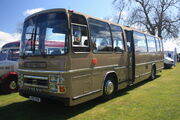
A typical Coach body on a Volvo chassis from the 1980s on show at the Boroughbridge Classic Vehicle show in 2009
- Main article: coach (vehicle)
A coach or motorcoach describes a more luxurious version of a bus, designed for more comfortable or longer-distance travel. In the UK, an old-fashioned word for it is a charabanc.
Coaches can come in the same general configurations as buses, as single- or double-deckers, articulated, or small 'mini-coaches'. Coaches have a higher floor level than buses, to let luggage be stored in compartments under the passenger floor. Larger coach designs are often heavier and have more power than buses of the same size, to let them travel at higher speeds on motorway or autoroute, and have more capacity for luggage. Coaches do not generally allow for standing passengers, and feature upholstered, high-backed, individual seats. Coaches often have passenger comforts such as reclining seats, hand luggage storage, toilets, and audio-visual entertainment systems. As a low-cost version of a coach, buses may be fitted with coach-style, higher-backed, more comfortable seats, termed 'dual-purposed' bodywork. These may be used on long-distance public transport services, or as low-cost charter coaches. Increasingly in some areas individual upholstered coach-style seating, either fully high-backed or standard bus-seat height, is being deployed on higher-specification transit buses, sometimes with leather upholstery.
Trolleybuses[]
- Main article: Trolleybus
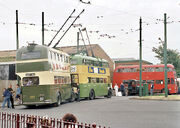
1950s trolley buses at the Black Country Living Museum
A trolleybus is essentially an electrically powered bus that is attached to and draws power from overhead lines. The trolleybus can be seen as a branch of, and a parallel development to, the conventional bus, and is exclusively used for public transport (apart from some systems recreated in transport museums). Trolleybuses appeared at nearly the same time as combustion engine powered buses, with a system in Dresden, Germany, in 5 May 1901. As with conventional buses, double-deck and articulated versions of the trolleybus have been developed.
Accessibility[]
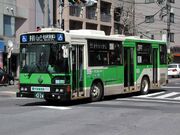
Modern low floor bus
Increasingly in some countries, buses and coaches are designed with accessibility features, often in response to regulations and recommendations laid out in disability discrimination laws. While such access laws apply to public transport, accessible features are also often adopted by private operators as a customer service differentiator, or due to the accessible designs becoming the market standard for new buses and coaches.
Historically, accessible buses were specially modified standard buses, as mobility buses, produced by post manufacture, or niche manufacturers. Later, many standard bus types have become accessible, although mobility buses are still in production, usually as minibus-size vehicles. Mobility buses can be modified with a side or rear wheelchair lift, additional doors, wider doors, or an extendible access ramp. For standard buses, a major part of accessibility is achieved by the low-floor bus design, although for coaches, accessibility is being achieved through wheelchair lifts due to their higher floor level. Easier access for wheelchairs, pushchairs and the elderly can also be achieved through the use of kneeling air suspension and electrically or hydraulically extended under-floor ramps. Other accessibility features include wide entrances and interior gangways for wheelchairs and baby carriages; brightly coloured interior fittings; and clear destination displays to aid the visually impaired.
Manufacturing[]
- Main article: Bus manufacturing
Early bus manufacturing grew out of carriage coachbuilding, and later out of automotive or truck manufacturers. Early buses were merely a bus body fitted to a truck chassis. This body+chassis approach has continued with modern specialist manufacturers, although there also exist integral designs such as the Leyland National where the two are practically inseparable. Specialist builders also exist and concentrate on building buses for special uses, or modifying standard buses into specialised products.
Integral designs have the advantages that they are have been well tested for strength, stability and so forth, and also are off-the-shelf. But there are, however, two incentives to use the chassis+body model. First it allows the buyer and manufacturer both to shop for the best deal for their needs, rather than having to settle on one fixed design— the buyer can choose the body and the chassis separately. Second it is likely that over the lifetime of a vehicle (in constant service and heavy traffic) that it will get minor damage now and again, and to be able easily to replace a body panel or window etc. can vastly increase its service life and save the cost and inconvenience of removing it from service.[citation (source) needed]
As with the rest of the automotive industry, into the 20th century bus manufacturing increasingly became globalization, with manufacturers producing buses far from their intended market to exploit labour and material cost advantages. As with the cars, new models are often exhibited by manufacturers at prestigious industry shows to gain new orders.[citation (source) needed]
Bus preservation[]
Rather than being scrapped or converted for other uses, sometimes retired buses are saved for preservation. This can be done by individuals, volunteer preservation groups or charitable trusts, museums, or sometimes by the operators themselves as part of a heritage fleet. These buses often need to undergo a degree of vehicle restoration to restore them to their original condition, and will have their livery and other details such as internal notices and rollsigns restored to be authentic to a specific time in the buses actual history. Some buses that undergo preservation are rescued from a state of great disrepair, while others enter preservation with very little wrong with them. As with other historic vehicles, many preserved buses either in a working or static state form part of the collections of transport museums. Working buses will often be exhibited at rallies and events, and are also used as charter buses. While many preserved buses are quite old or even vintage, in some cases relatively new examples of a bus type can enter restoration, while in service examples are still in use by other operators. This often happens when a change in design or operating practice, such as the switch to one person operation or low floor technology, renders some buses redundant while still relatively new.
See also[]
References[]
This definition of a term used in some articles is an extract of the wikipedia article.
- This article incorporates text from the Encyclopædia Britannica, Eleventh Edition, a publication now in the Public Domain.
- ↑ "China's longest bus unveiled in Shanghai", Jongo News (15 March 2007).
- ↑ web-page (in French) at http://www.herodote.net/histoire/evenement.php?jour=18260810, retrieved 13 June 2008
External links[]
| |||||||||||||||||||||||||||||||||||||||||||||||||||||||||||||||||||||||||
| This page uses some content from Wikipedia. The original article was at Bus. The list of authors can be seen in the page history. As with Tractor & Construction Plant Wiki, the text of Wikipedia is available under the Creative Commons by Attribution License and/or GNU Free Documentation License. Please check page history for when the original article was copied to Wikia |